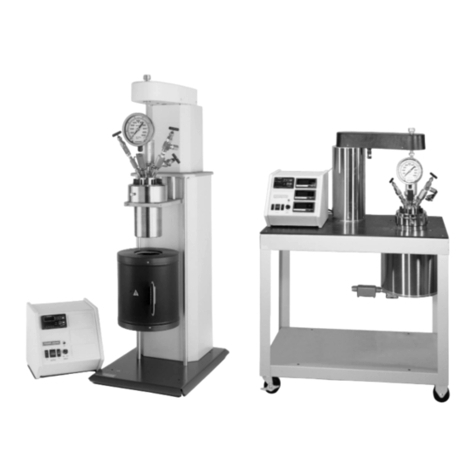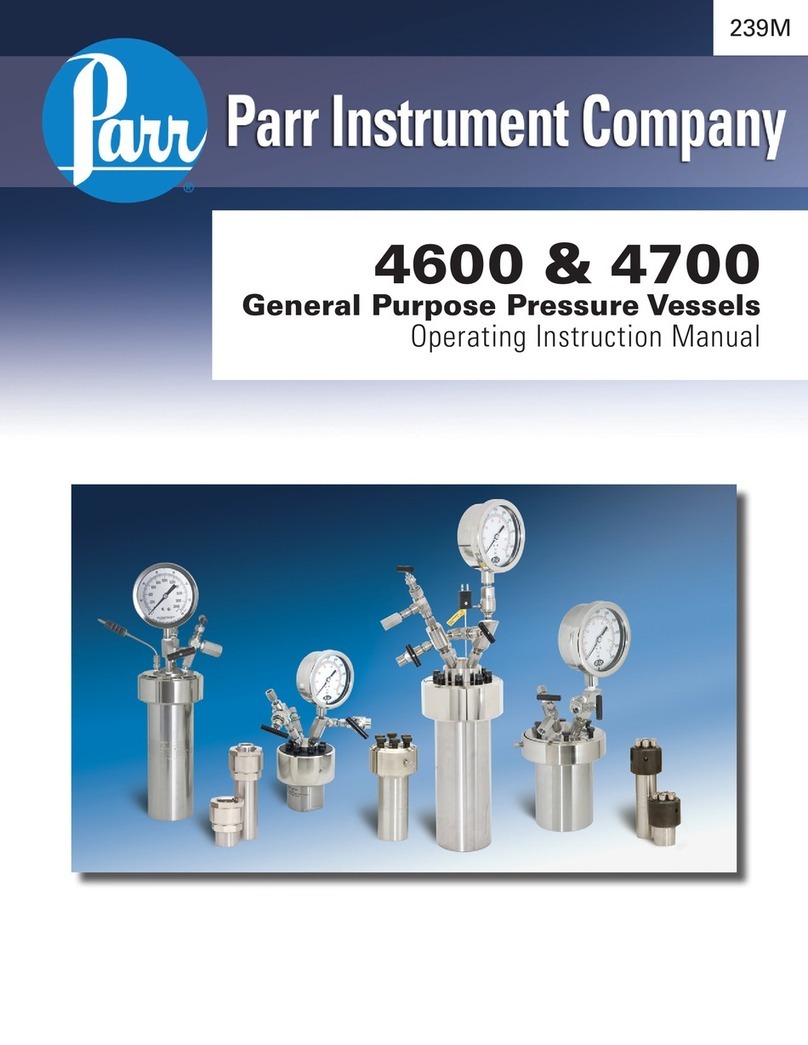
4590 Micro Reactors
Parr Instrument Company
4
PREFACE
Scope
These instructions describe the installation, opera-
tion and maintenance of Parr Series 4590 BenchTop
Micro Reactors which are offered in three sizes 25,
50 and 100 mL.They cover the basic steps to be fol-
lowed when installing these reactors and describe
the function of all standard components.They are
intended to be used in conjunction with several
related instruction sheets listed below.This infor-
mation describes several components which are
common to most Parr pressure reaction equipment,
and includes safety precautions and other related in-
formation applicable to all reaction laboratories.The
users should study all of these instructions carefully
before starting to use these vessels so that they will
fully understand the capabilities and limitations of
the equipment.
Related Instructions
The following Parr publications are also included to
further your understanding of this instrument and
its component parts:
No. Description
201M Limited Warranty
230M Safety Precautions to be observed when
operating Pressure Reaction Equipment
231M Operating Instructions for Parr Safety
Rupture Discs
234M Operating and Maintenance Instructions
for Parr Magnetic Drives
323M Operating Instructions for Parr Pressure
Relief Valves
548M Operating Instructions for 4848 Reactor
Controllers
FX004 Health & Safety Assurance Certification
Intended Usage
This system has been designed for use as a high
pressure reactor system. It has been designed, built,
and tested to strict physical and electrical standards.
However, it is the user’s responsibility to install and
operate it in conformance with local pressure and
electrical codes.
If this equipment is used in a manner beyond its
intended usage, the protection provided by the
equipment may be impaired.
Safety Information
To avoid electrical shock, always:
1. Use a properly grounded electrical outlet of
correct voltage and current handling capability.
2. Ensure that the equipment is connected to
electrical service according to local national
electrical codes. Failure to properly connect may
create a fire or shock hazard.
3. For continued protection against possible hazard,
replace fuses with same type and rating of fuse.
4. Disconnect from the power supply before
maintenance or servicing.
To avoid personal injury:
1. Do not use in the presence of flammable or
combustible materials; fire or explosion may
result.This device contains components which
may ignite such material.
2. Refer servicing to qualified personnel.
General Specifications
Electrical Ratings
Controller ratings are found in the Operating Instruc-
tions for the controller supplied with your reactor
and on the controller data plate.
Before connecting a controller to an electrical outlet,
the user must be certain that the electrical outlet has
an earth ground connection and that the line, load
and other characteristics of the installation do not
exceed the following limits:
Voltage: Fluctuations in the line voltage should not
exceed 10% of the rated nominal voltage shown on
the data plate.
Frequency: Controllers can be operated from either
a 50 or 60 Hertz power supply without affecting their
operation or calibration.
Current: The total current drawn should not exceed
the rating shown on the data plate on the controller
by more than 10 percent.
Thermocouple: Unless otherwise specified, all
Series 4848 Controllers operate with aType J (iron-
constantan) thermocouple. The total resistance of
the thermocouple and the lead wires should not
exceed 100 ohms. If the resistance of the thermo-
couple circuit is higher, it will reduce the sensitivity
of the control system.
Artisan Technology Group - Quality Instrumentation ... Guaranteed | (888) 88-SOURCE | www.artisantg.com































